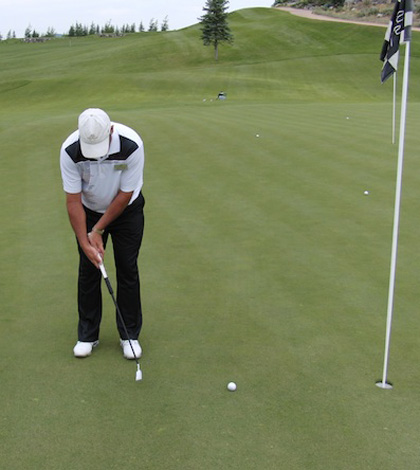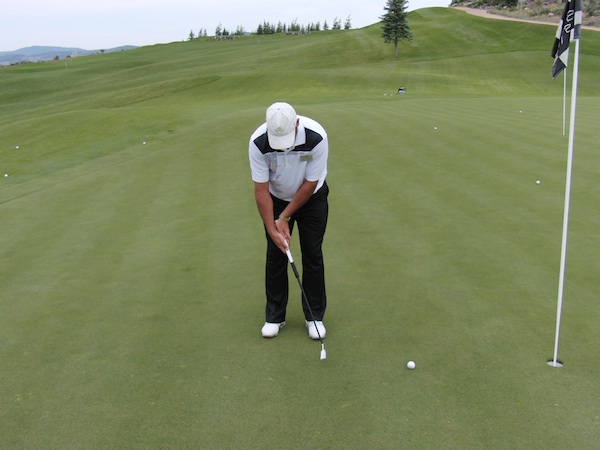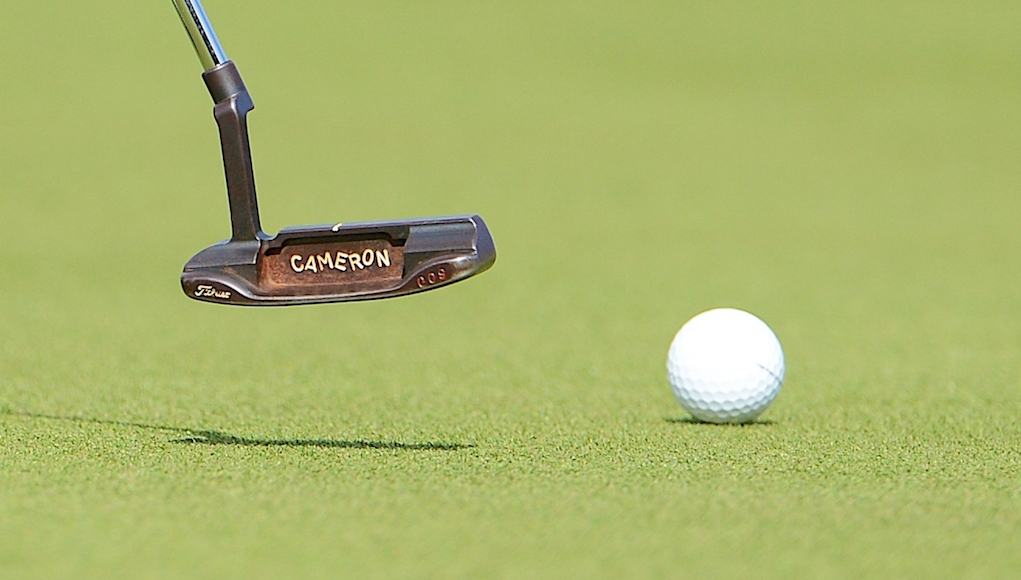Instruction
The Top 10 Short Game Mistakes

Over the years of instructing, I have noticed many things that people tend to do incorrectly within their short games that continues to cost these players shot after shot, day after day! It pains me to see these wasted shots; furthermore, it screws up your round.
The short game experts have noted for years that improving the short game is the best way to lower your scores and your subsequent handicap — so I urge you to give it a try!
Below you will find the “Top 10 Short Game Mistakes” that I see day after day in my instructional academies. These mistakes below affect the beginning golfer, as well as the single-digit handicapper. Thus, these tips will give you lifelong success around the greens regardless of who you are. Enjoy!
Putting
The Hand Slap
If you look at the address position of your hands in the mirror, you will notice that the forward wrist is for all intents and purposes “flat,” while the rear wrist is bent. This allows the hands to lead and power the shaft and putter head during the stroke. When these alignments are maintained into the backstroke, at impact and into the follow-through, you will have much better control of the direction and speed of your putts. Remember that the forward hand controls the direction that the ball leaves the blade, while the rear hand controls the loft of the blade; thus, if you can’t control your impact alignments you will surely fail on the greens.
In the mirror, practice making strokes monitoring these alignments. You will notice that when you do, your putter blade will have a very solid stroke path driven by the shoulders. At the finish, you should see the same wrist alignments that you began with. But if you see that the rear wrist is flat and the forward wrist is bent, then you will have the dreaded “hand slap” that causes many people to putt poorly. This is a “look, look, look” situation and all it takes to eliminate this slap once and for all is a few daily strokes in the mirror monitoring your hands.
The Illusion of the Putter shaft
If you address the putter in the mirror and look down, you will see that from the player’s eyes the club shaft looks perpendicular to the ground. However, if you look up in the mirror you will see that the shaft is leaning backwards slightly. This is the Illusion of the putter shaft.
Putter manufacturers have placed the shaft behind the blade for whatever reasons, but it is up to the player to understand this illusion because it is different with all putters. If you do not, then you will always place the hands behind the putter head at address and find it impossible for the hands to lead the club through impact.
A good rule of thumb is to forward press your hands to the first belt-loop of the belt buckle toward your target. This usually puts the putter shaft into better position. You must take the time to use your eyes and your mirror to understand this principle, because only you know what you see from above. So you must decipher the correct position of your hands and club shaft even though the eyes are receiving poor information due to the “Illusion of the putter shaft.”
Chipping
The Ball’s Position
The most deadly mistake in chipping is the dreaded chili-dip. I hate to see anyone slap at it and move the ball about two feet, because to your score it is almost as deadly as the outright shank!
Whenever I see the chili-dip, I usually notice one thing right from the start, even before the backstroke has begun — the ball’s position. In order to hit a chip effectively, you must have the ball in front of your rear foot so that you can impart a descending blow to the ball while using the proper type of swing that will be described below. Most of the time I notice in my chipping lessons that the ball is center to forward in the stance. That’s asking … begging to be mishit!
Please take the time and place the ball in the proper position in your stance from the beginning or you will have a tougher time with chipping than you really need to have. It is from this distance that you should be thinking about making a few from off the green, not struggling to hit it solidly.
Use a Putting Stroke, NOT a Hit
Now that you have the ball in the correct position, directly in front of your rear toe, the next thing is to give the club the ability to produce very solid and controllable shots while this close to the green. The biggest mistake I see with chipping, next to the improper ball position, is using a “hitting” type of motion as you would use in your full swing. That causes the impact alignments (mentioned in the putting section) to break down. This soft shot requires a “putting” stroke where the hands are dead with no wrist break on the way back or through. This is the key to chipping well and the biggest mistake I see from day to day.
The “hit” will cause your hands to become overactive through the ball and this will cause the ball to leave the blade in an uncontrolled fashion. Around the greens, especially in chipping, you need all the “touch” possible because if you are this close to the green you should at least get up and down 50 percent of the time or more. Use your putting stoke and you will see just how much easier this will become!
Pitching
The Role of the Ball’s Position
The first question I ask anyone trying to hit a pitch shot is what trajectory are they going to use? If they can answer that question, then the next question I ask them is what ball position accommodates the trajectory they are trying to use?
Ninety percent of the time I see players trying to hit pitch shots with the ball in the rear of their stances. This is fine if you are trying to hit it low, but if you have another trajectory in mind then you will have to manipulate your weight and/or hands through the ball, which is an unreliable action at best. I will give you a simple way to hit the ball varying trajectories — by moving the ball around in your stance. Yes, there are other ways to hit the ball higher or lower, but this is the most foolproof way I know to keep it very simple.
If you are trying to hit the ball high, put the ball in the forward portion of your stance. If you are trying to hit the ball your normal height then place the ball under your sternum. Finally, if you desire to hit the ball lower, place the ball in the rear portion of your stance. These three simple ball positions must match up with the shot you are trying to hit or you are history around the greens for sure.
The Shank
Nothing in the world can ruin your day faster than the shank for sure, but in order to get out of this dilemma you must first understand WHY you are shanking it. Article after article has been written about techniques that get you out of the shanks, but few I have read address the real problem — the swing’s path.
When you shank the ball, your swing path is either either moving severely in-to-out or out-to-in.Whatever the reason for it, the bottom line is that if you don’t know what swing path you are using to shank the ball then you’re not going to have a lot of luck fixing the shanks! There are two simple drills for the shanker:
In-to-out shanker: Place a head cover or board just outside your target line and you will be forced to make a better pivot motion through the ball. This will help fix the in-to-out path. This drill is very effective because it gives instant feedback as to when a golfer swings too much from the inside. If they do, they hit the headcover.
Out-to-in shanker: Place a headcover just outside the ball but angle it toward right field (for the right-handed golfer). Try and make swings from the inside and hit the extreme inside of the ball, but don’t hit the headcover. This will force your swing path to be from the inside — not over the top as you have swung in the past.
These two drills work best if you start with small pitch shots and work op from there SLOWLY. You must gain your confidence first, and then you can add speed!
Bunkers
Improper Side Bending at Address
It seems that most people tend to hit the ball fat or thin out of the bunkers. If you seem to always hit it fat, then this is the tip for you. In the regular shot set-up, you will always have your spine leaning rearward, but in bunkers you want just the opposite. Your spine in the bunker should lean slightly to the forward of center.
This causes the low point of your swing to occur later than normal, eliminating the fat shots. When you lean your spine too much to the rear at address, then you will find that your weight will tend to “hang back” through impact, increasing the probability that the low point of the swing arc will occur too early. That makes you hit fat shots.
This hang back will also cause many other things to happen, but if you want to avoid all these poor shots then just simply lean your spine to the left. Using the “line” drill and this new spine tilt you will be better able to track when the club bottoms out. This will help you to have consistency out of the bunkers like never before.
The “U” versus the “V”
When you hit the ball thin and over the green head high at Mach 1, then you will be like the millions of golfer who don’t understand the “angle of attack” and what it will do to the ball’s flight out of a bunker. Most golf shots are struck with a “U” type of action, where the club gently rises and falls, like the letter “U.”
But, in a bunker when you are trying to hit a softer shot to a tight pin, you must hit the sand first. To do this you must re-arrange your swing’s path to look like a “V.”
This quick setting of the wrists and steeper angle of attack will cause you to hit the sand behind the ball. Your job is to keep moving and not cut off the forward swing! If you are successful in changing your angle of attack, then you will notice that for shorter shots the “V” is best and for very long bunker shots, where a lower shot is more acceptable, the “U” will work as long as you set your wrists enough to hit the sand. Experiment and you will love the results!
The Mental Game
Where to Leave the Ball
During schools, I see people hitting shots around the green with absolutely no regard for where they are leaving the ball. I would rather have a day of 10-foot uphill right-to-left putts (as a right-handed player) than a 5-foot downhill left-to-right sliding putt on fast greens. If you doubt this fact, come to the mountains and hit the ball above the hole!
Remember this: In darts you aim at a very small target on the board, not at the total board, and thus, your dispersion pattern is very tight to your target. Golf is the same way — if you just aim at the hole, you will have a wide array of shots and putts to make. But if you aim at a certain quadrant of the hole, then you will find a much tighter dispersion of shots, not to mention easier putts in general!
Dial-a-Shot
When people come up to the green and have a simple pitch, shot I usually see them grab the lob wedge and head off to the other side of the green to hit their shot. This is the last thing I try and have my students do! I want you to have options –“dial-a-shot” the pros call it– where you have one shot with several ideas on how to play it.
There are times where the shot calls for one type of execution, but your nerves call for another or vice-versa. If you only have one way to play shots around the greens, then you are severely limiting yourself on the golf course. Take the time to experiment with different clubs under different circumstances and you will see that sometimes a putter is a better choice over the 7 iron, or the lob wedge is better than the pitching wedge. Whatever the choice, take your time to think and identify what you are trying to do and you will be much happier with the results.
I hope by now you have seen that these mistakes plague many players from good to bad. Take your time and eliminate the top-10 mistakes and your scores will lower. I guarantee it!
Instruction
The Wedge Guy: Beating the yips into submission

There may be no more painful affliction in golf than the “yips” – those uncontrollable and maddening little nervous twitches that prevent you from making a decent stroke on short putts. If you’ve never had them, consider yourself very fortunate (or possibly just very young). But I can assure you that when your most treacherous and feared golf shot is not the 195 yard approach over water with a quartering headwind…not the extra tight fairway with water left and sand right…not the soft bunker shot to a downhill pin with water on the other side…No, when your most feared shot is the remaining 2- 4-foot putt after hitting a great approach, recovery or lag putt, it makes the game almost painful.
And I’ve been fighting the yips (again) for a while now. It’s a recurring nightmare that has haunted me most of my adult life. I even had the yips when I was in my 20s, but I’ve beat them into submission off and on most of my adult life. But just recently, that nasty virus came to life once again. My lag putting has been very good, but when I get over one of those “you should make this” length putts, the entire nervous system seems to go haywire. I make great practice strokes, and then the most pitiful short-stroke or jab at the ball you can imagine. Sheesh.
But I’m a traditionalist, and do not look toward the long putter, belly putter, cross-hand, claw or other variation as the solution. My approach is to beat those damn yips into submission some other way. Here’s what I’m doing that is working pretty well, and I offer it to all of you who might have a similar affliction on the greens.
When you are over a short putt, forget the practice strokes…you want your natural eye-hand coordination to be unhindered by mechanics. Address your putt and take a good look at the hole, and back to the putter to ensure good alignment. Lighten your right hand grip on the putter and make sure that only the fingertips are in contact with the grip, to prevent you from getting to tight.
Then, take a long, long look at the hole to fill your entire mind and senses with the target. When you bring your head/eyes back to the ball, try to make a smooth, immediate move right into your backstroke — not even a second pause — and then let your hands and putter track right back together right back to where you were looking — the HOLE! Seeing the putter make contact with the ball, preferably even the forward edge of the ball – the side near the hole.
For me, this is working, but I am asking all of you to chime in with your own “home remedies” for the most aggravating and senseless of all golf maladies. It never hurts to have more to fall back on!
Instruction
Looking for a good golf instructor? Use this checklist

Over the last couple of decades, golf has become much more science-based. We measure swing speed, smash factor, angle of attack, strokes gained, and many other metrics that can really help golfers improve. But I often wonder if the advancement of golf’s “hard” sciences comes at the expense of the “soft” sciences.
Take, for example, golf instruction. Good golf instruction requires understanding swing mechanics and ball flight. But let’s take that as a given for PGA instructors. The other factors that make an instructor effective can be evaluated by social science, rather than launch monitors.
If you are a recreational golfer looking for a golf instructor, here are my top three points to consider.
1. Cultural mindset
What is “cultural mindset? To social scientists, it means whether a culture of genius or a culture of learning exists. In a golf instruction context, that may mean whether the teacher communicates a message that golf ability is something innate (you either have it or you don’t), or whether golf ability is something that can be learned. You want the latter!
It may sound obvious to suggest that you find a golf instructor who thinks you can improve, but my research suggests that it isn’t a given. In a large sample study of golf instructors, I found that when it came to recreational golfers, there was a wide range of belief systems. Some instructors strongly believed recreational golfers could improve through lessons. while others strongly believed they could not. And those beliefs manifested in the instructor’s feedback given to a student and the culture created for players.
2. Coping and self-modeling can beat role-modeling
Swing analysis technology is often preloaded with swings of PGA and LPGA Tour players. The swings of elite players are intended to be used for comparative purposes with golfers taking lessons. What social science tells us is that for novice and non-expert golfers, comparing swings to tour professionals can have the opposite effect of that intended. If you fit into the novice or non-expert category of golfer, you will learn more and be more motivated to change if you see yourself making a ‘better’ swing (self-modeling) or seeing your swing compared to a similar other (a coping model). Stay away from instructors who want to compare your swing with that of a tour player.
3. Learning theory basics
It is not a sexy selling point, but learning is a process, and that process is incremental – particularly for recreational adult players. Social science helps us understand this element of golf instruction. A good instructor will take learning slowly. He or she will give you just about enough information that challenges you, but is still manageable. The artful instructor will take time to decide what that one or two learning points are before jumping in to make full-scale swing changes. If the instructor moves too fast, you will probably leave the lesson with an arm’s length of swing thoughts and not really know which to focus on.
As an instructor, I develop a priority list of changes I want to make in a player’s technique. We then patiently and gradually work through that list. Beware of instructors who give you more than you can chew.
So if you are in the market for golf instruction, I encourage you to look beyond the X’s and O’s to find the right match!
Instruction
What Lottie Woad’s stunning debut win teaches every golfer

Most pros take months, even years, to win their first tournament. Lottie Woad needed exactly four days.
The 21-year-old from Surrey shot 21-under 267 at Dundonald Links to win the ISPS Handa Women’s Scottish Open by three shots — in her very first event as a professional. She’s only the third player in LPGA history to accomplish this feat, joining Rose Zhang (2023) and Beverly Hanson (1951).
But here’s what caught my attention as a coach: Woad didn’t win through miraculous putting or bombing 300-yard drives. She won through relentless precision and unshakeable composure. After watching her performance unfold, I’m convinced every golfer — from weekend warriors to scratch players — can steal pages from her playbook.
Precision Beats Power (And It’s Not Even Close)
Forget the driving contests. Woad proved that finding greens matters more than finding distance.
What Woad did:
• Hit it straight, hit it solid, give yourself chances
• Aimed for the fat parts of greens instead of chasing pins
• Let her putting do the talking after hitting safe targets
• As she said, “Everyone was chasing me today, and managed to maintain the lead and played really nicely down the stretch and hit a lot of good shots”
Why most golfers mess this up:
• They see a pin tucked behind a bunker and grab one more club to “go right at it”
• Distance becomes more important than accuracy
• They try to be heroic instead of smart
ACTION ITEM: For your next 10 rounds, aim for the center of every green regardless of pin position. Track your greens in regulation and watch your scores drop before your swing changes.
The Putter That Stayed Cool Under Fire
Woad started the final round two shots clear and immediately applied pressure with birdies at the 2nd and 3rd holes. When South Korea’s Hyo Joo Kim mounted a charge and reached 20-under with a birdie at the 14th, Woad didn’t panic.
How she responded to pressure:
• Fired back with consecutive birdies at the 13th and 14th
• Watched Kim stumble with back-to-back bogeys
• Capped it with her fifth birdie of the day at the par-5 18th
• Stayed patient when others pressed, pressed when others cracked
What amateurs do wrong:
• Get conservative when they should be aggressive
• Try to force magic when steady play would win
• Panic when someone else makes a move
ACTION ITEM: Practice your 3-6 foot putts for 15 minutes after every range session. Woad’s putting wasn’t spectacular—it was reliable. Make the putts you should make.
Course Management 101: Play Your Game, Not the Course’s Game
Woad admitted she couldn’t see many scoreboards during the final round, but it didn’t matter. She stuck to her game plan regardless of what others were doing.
Her mental approach:
• Focused on her process, not the competition
• Drew on past pressure situations (Augusta National Women’s Amateur win)
• As she said, “That was the biggest tournament I played in at the time and was kind of my big win. So definitely felt the pressure of it more there, and I felt like all those experiences helped me with this”
Her physical execution:
• 270-yard drives (nothing flashy)
• Methodical iron play
• Steady putting
• Everything effective, nothing spectacular
ACTION ITEM: Create a yardage book for your home course. Know your distances to every pin, every hazard, every landing area. Stick to your plan no matter what your playing partners are doing.
Mental Toughness Isn’t Born, It’s Built
The most impressive part of Woad’s win? She genuinely didn’t expect it: “I definitely wasn’t expecting to win my first event as a pro, but I knew I was playing well, and I was hoping to contend.”
Her winning mindset:
• Didn’t put winning pressure on herself
• Focused on playing well and contending
• Made winning a byproduct of a good process
• Built confidence through recent experiences:
- Won the Women’s Irish Open as an amateur
- Missed a playoff by one shot at the Evian Championship
- Each experience prepared her for the next
What this means for you:
• Stop trying to shoot career rounds every time you tee up
• Focus on executing your pre-shot routine
• Commit to every shot
• Stay present in the moment
ACTION ITEM: Before each round, set process goals instead of score goals. Example: “I will take three practice swings before every shot” or “I will pick a specific target for every shot.” Let your score be the result, not the focus.
The Real Lesson
Woad collected $300,000 for her first professional victory, but the real prize was proving that fundamentals still work at golf’s highest level. She didn’t reinvent the game — she simply executed the basics better than everyone else that week.
The fundamentals that won:
• Hit more fairways
• Find more greens
• Make the putts you should make
• Stay patient under pressure
That’s something every golfer can do, regardless of handicap. Lottie Woad just showed us it’s still the winning formula.
FINAL ACTION ITEM: Pick one of the four action items above and commit to it for the next month. Master one fundamental before moving to the next. That’s how champions are built.
PGA Professional Brendon Elliott is an award-winning coach and golf writer. You can check out his writing work and learn more about him by visiting BEAGOLFER.golf and OneMoreRollGolf.com. Also, check out “The Starter” on RG.org each Monday.
Editor’s note: Brendon shares his nearly 30 years of experience in the game with GolfWRX readers through his ongoing tip series. He looks forward to providing valuable insights and advice to help golfers improve their game. Stay tuned for more Tips!
































Golfraven
May 14, 2014 at 5:42 pm
After a not so great round today I see where I left the shots. Putting and chipping. I may switch to the cross handed grip to keep the front hand more straight and passive. I didnt strike it well on longer putts. I watched a video of Jordan Spieth chipping and he also talks about the ball position being more towards the rear foot.
Through your great insight I am more aware of those fundamentals and I can pay more attention to it even when watching golf on TV.
spencer
Aug 7, 2013 at 12:14 am
WRT to the ball position in pitch shots to control height – does the varying ball positions affect the amount of spin you can have on the ball? I would imagine that if I moved the ball forward to play a higher shot, that I would be catching it on the upswing and thus higher on the club face…would that make it spin less?
Scott R
Aug 5, 2013 at 9:12 pm
Excellent article Tom – – I really enjoyed it. I’ve let several of these problems creep back into my game over time and these reminders will help eliminate some poor shots.
Kevin P Donovan
Aug 5, 2013 at 11:53 am
Tom, thanks for the tips. I have had some tough rounds lately. More practice is in order and I will use some of your tried and true tips. Oh and thanks for talking us lefties thru your lessons. That is a rare treat, trust me I know.
thanks, Kev
Jerry M. Priester
Aug 7, 2013 at 7:14 pm
Tom, I am really proud to be able to say that I have had you as a teacher. Granted it was a loooong time ago at Houston Levee Golf Club in Collierville Tennessee but I still remember the time. I have followed your career and hope to have a lesson from you again someday. Take care and hit them long and straight.
Jerry Priester
Priester And Associates, Inc..
General Contractors